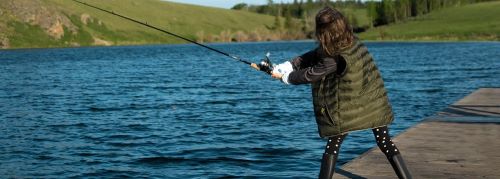Whether fishing a new lake or trying to locate fish, lure fishing is a great technique for covering lots of water. Easily mastered using just a spinning rod and reel, it’s ideal for those new to angling. This method can be particularly productive when fishing for predatory species or, in warmer weather, when trout are not actively feeding.
The lure is constantly cast out and retrieved, or jigged until you feel the smashing strike of a fish. Whereas bait fishing is a static activity (as you patiently watch for your bobber to dip before retrieving), fishing with lures is active and dynamic, and can be lots of fun.
Spoons and Spinners
There are two main categories of lures: spoons and spinners. Spoons wobble and dart as you reel them in. This movement mimics a wounded baitfish, which entices trout to bite. There are myriad designs, colours, and sizes of spoons available for you to tailor for the water, type of fishing, and target species. The spoon should match the size of the fish: use a smaller spoon for rainbow trout in a small lake, and larger ones to troll for big trout in large lakes. Attaching a swivel to the line above the spoon will reduce line twist. Common spoons used when fishing for rainbow trout include the Luhr Jensen Krockodile, Dick Nite, Gibbs-Delta Croc, Mepp’s Syclops, or Hildebrandt spoons.

Spinners have a rotating blade on the front which produces vibrations and flashes of light as the lure moves through the water. The hook can either be exposed, or covered by some type of “dressing,” like feathers. Some popular choices for rainbow trout are the Worden’s Rooster Tail, Gibbs Silvex, or Mepp’s spinners. Ask your local tackle shop for their recommendations.

Fish change their preferred food, so don’t be afraid to try a few different lures.
Fishing Methods
Lures can be cast and retrieved, trolled, or jigged.
Casting and Retrieving
When casting and retrieving, cover large parts of the water column by changing how long you let the lure sink, and the speed at which you retrieve the lure. Add a small split shot weight to your leader line if you need to cast further, or to help sink your lure deeper. Keep the rod tip pointed down while retrieving to help keep your lure at the desired depth, and lessen the arc needed to set the hook when a fish hits.

Trolling
Another lure-fishing technique is trolling: dragging a spoon or spinner behind a boat. In shallow water (less than six metres deep), you can simply add your lure of choice to your mainline with a leader. In deeper water, you can add additional weight to your mainline, use a sinking lead line, or consider using a downrigger that will help lower your offering to the desired depth.
Jigging
While it is possible to jig with a spoon or a spinner, a dedicated jigging lure like a Buzz Bomb is more effective. From a boat or dock, let the lure flutter and dart in the water by making a short lift up with your rod, and then quickly dropping it back down. You can also cast your lure out, and lift-drop both as it sinks and while you retrieve it. Jigging works well when fish are deep in the water column. Since strikes commonly occur when your lure is descending, be ready to set the hook if you feel any kind of a pause or bump during its drop.
Tips for Success
When fishing with lures, it is important to know how deep the water is, and to adjust the depth at which you are fishing accordingly. Remember that many fish like to hide near underwater structure and vegetation, and where the shoals of the lake drop off into deeper water.
Check your lure frequently for weeds. Weeds on your lure are an indication that you are dragging the lure along the bottom of the lake. If you find that fish are following but not striking, try varying your retrieval speed, or simply pause and then reel again – this might confuse the fish enough to bite.
Fishing with lures is a fun and effective way to target rainbow trout. Add a few lures to your fishing arsenal, and have them ready to go in your tackle box.
Author: Staff, Freshwater Fisheries Society of BC
Images: Freshwater Fisheries Society of BC, Nick Basok, Dan
